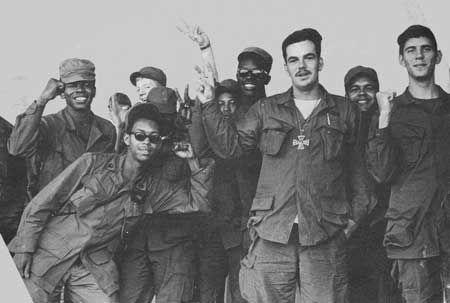About 302 black sailors had become tired of the discrimination being meted out to them in the navy by white sailors and captains. In the Navy at the time, black sailors were typically assigned to the ship’s most miserable jobs.
On the parapet of civil rights movement at home, the sailors reckoned they were being treated as second class citizens so in October 1972 they registered their displeasure on the aircraft carrier USS Kitty Hawk enroute to her station in the Gulf of Tonkin off Vietnam. The ship already had been deployed for eight months, and was on track to spend a record number of days at sea with a grueling pace of flight operations to support U.S. troops in Vietnam.
On the afternoon of October 12, while Kitty Hawk was participating in Operation Linebacker off the coast of North Vietnam, African American sailor Perry Pettus went on deck with two other black sailors. The three were approached by two Marines who told them, “You blacks can’t walk in over two’s.” When the black sailors ignored them and kept walking, Pettus was put into a stranglehold from behind with a nightstick by one of the Marines.

When 18-year-old black Airman Apprentice Terry Avinger wanted two sandwiches, he was told by a white mess cook that he was only allowed one. The black sailor reached across the food line and grabbed an extra sandwich, a shouting match ensued. A series of happenings then led to the worst shipboard riot in U.S. Navy history.
“The ship of 4,500 sailors with only 302 being black erupted into chaos when angry black sailors roamed the ship’s passageways, beating white sailors with makeshift weapons such as broom handles, wrenches and pieces of pipe. By the next day, over 50 sailors, nearly all white, were injured, some severe enough to be evacuated from the ship to onshore hospitals. The fallout would see a number of black sailors being disciplined for their role in the incident.”
The race riot involved more than 100 sailors. Eventually 26 men, all black, were charged with assault and rioting and were ordered to appear before a court-martial in San Diego.
“Four days later, a group of about 12 black sailors aboard the USS Hassayampa, a fleet oiler docked at Subic Bay, told ship’s officers that they would not sail with the ship when the ship put to sea. The group demanded the return of money that allegedly had been stolen from the wallet of one of the group. The ship’s leadership failed to act quickly enough to defuse the situation and later that day, a group of seven white sailors were set upon by the group and beaten. It took the arrival of a Marine detachment to restore order. Six black sailors were charged with assault and rioting.”

Admiral Elmo R. Zumwalt, Jr., Chief of Naval Operations, instituted new race relations programs and made significant changes to Naval Regulations to address many of the very real issues raised by the black sailors regarding racial injustice in the Navy.
The unrest in the Navy was serious enough to arrest the attention of Congress, and by the end of 1972 it held hearings looking into the incidents.
In the final report of the subcommittee investigating the incident, the Kitty Hawk riot as well as other fleet incidents were due to widespread “permissiveness” in the Navy defined by a lack of willingness by seniors to enforce Navy rules.
“Although we have been able to investigate only certain specific incidents in depth, the total information made available to us indicates the condition could be service wide,” the report said.

“A total of 21 men were charged for their roles in the riots, with 16 of them requesting to be tried by court-martial and flown back to San Diego to face trial. The remaining five accepted non-judicial punishments during the ship’s transit home.
“Approximately 50 sailors — all but six white — were treated for injuries sustained the night of Oct 12. Three were so serious they required evacuation to onshore medical facilities while the rest were treated aboard the ship.”
Interviews with some of the Black agitators revealed a feeling of “being trapped in low ranks, of being unable to get high test scores or the recommendations of superiors for promotions to higher pay and better jobs; of getting harsher punishment than whites at captain’s mast, the Navy equivalent of a magistrate or justice‐of‐the‐peace court.”
The USS Kitty Hawk riot is the first mass mutiny in the history of the U. S. Navy and were it not for military law, the incident might be passed off as a demonstration.










